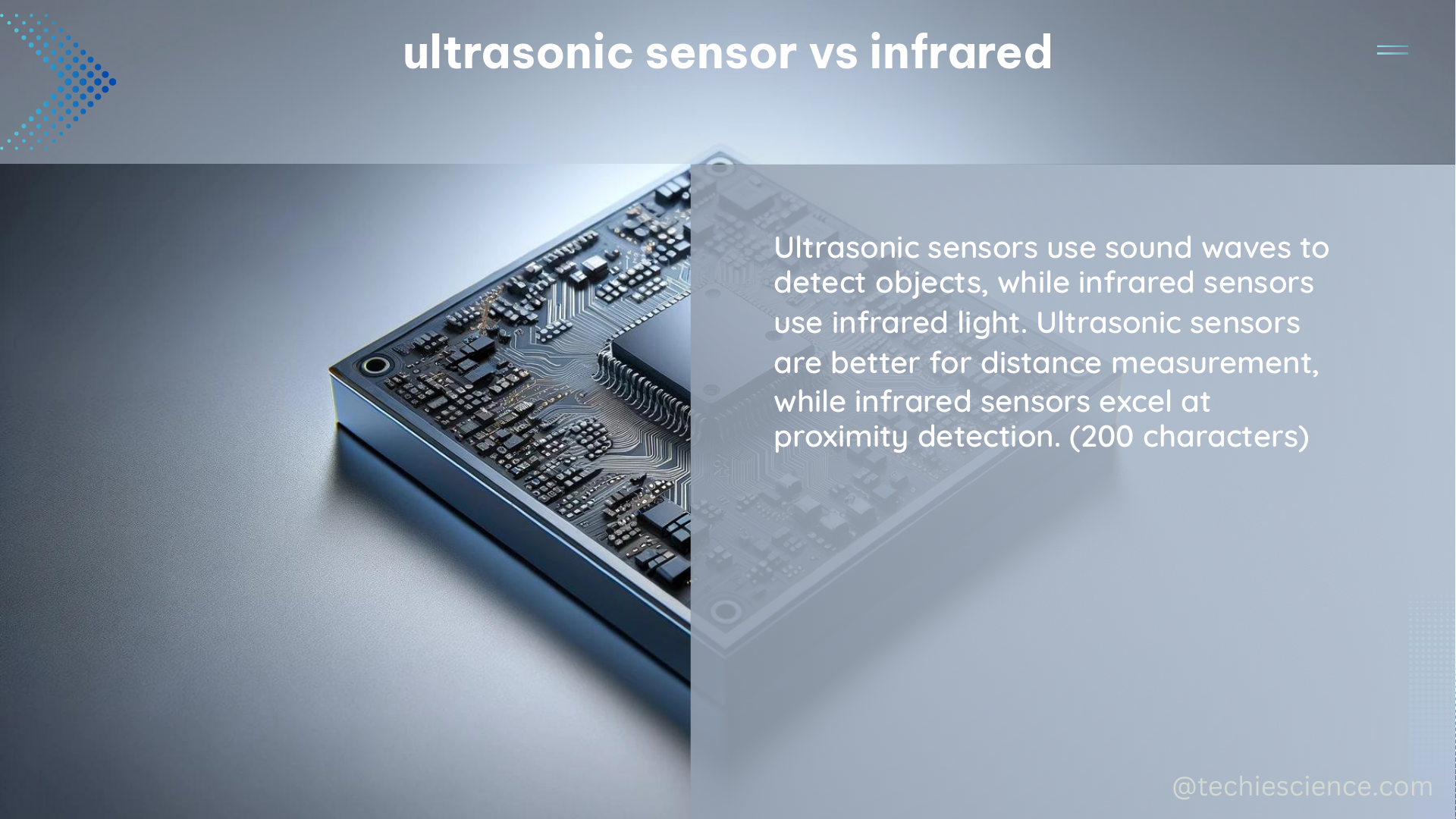Ultrasonic sensors and infrared sensors are two widely used technologies in various applications, from robotics and automation to security and distance measurement. Understanding the technical specifications, advantages, and limitations of these sensors is crucial when selecting the right solution for a specific application. In this comprehensive guide, we will delve into the intricacies of ultrasonic sensors and infrared sensors, providing you with a detailed comparison to help you make an informed decision.
Operating Principle
Ultrasonic Sensors
Ultrasonic sensors operate by emitting high-frequency sound waves, typically in the range of 40 kHz to 400 kHz, and measuring the time it takes for the sound wave to bounce back after hitting an object. This time-of-flight (ToF) measurement is then used to calculate the distance to the object. Ultrasonic sensors can detect objects by measuring the reflection of the sound waves, making them effective in a wide range of environmental conditions, including low-light or dark environments.
Infrared Sensors
Infrared sensors, on the other hand, utilize the infrared spectrum of the electromagnetic radiation to detect objects. These sensors can be classified into two main types:
-
Passive Infrared (PIR) Sensors: PIR sensors detect the infrared radiation emitted by objects, such as the heat signature of a person or an animal. They are commonly used in motion detection and security applications.
-
Active Infrared Sensors: Active infrared sensors emit infrared radiation and detect the reflection off objects. They are often used in distance measurement and object detection applications.
Detection Range and Accuracy

Ultrasonic Sensors
Ultrasonic sensors typically have a detection range of 2 cm to 5 meters, depending on the specific model and manufacturer. They are known for their high accuracy, with most models achieving an accuracy of ±1% to ±3% of the measured distance. This makes them suitable for applications that require precise distance measurement, such as in robotics, automation, and industrial processes.
Infrared Sensors
Infrared sensors generally have a shorter detection range compared to ultrasonic sensors, typically within the range of 10 cm to 1 meter. They tend to have a lower accuracy, with most models achieving an accuracy of ±5% to ±10% of the measured distance. This lower accuracy is due to the sensitivity of infrared sensors to environmental factors, such as lighting conditions and the reflective properties of the target object.
Environmental Factors
Ultrasonic Sensors
Ultrasonic sensors are relatively unaffected by lighting conditions, as they rely on sound waves rather than electromagnetic radiation. However, they can be influenced by environmental factors such as temperature and humidity. Changes in these parameters can affect the speed of sound, which can impact the accuracy of the distance measurement.
Infrared Sensors
Infrared sensors, on the other hand, can be significantly affected by lighting conditions. The presence of other infrared sources, such as sunlight or artificial lighting, can interfere with the sensor’s ability to accurately detect and measure the target object. Additionally, the reflective properties of the target object can also impact the performance of infrared sensors.
Applications
Ultrasonic Sensors
Ultrasonic sensors are widely used in applications that require high accuracy and long detection ranges, such as:
- Robotics and automation: Obstacle detection, collision avoidance, and position control
- Industrial automation: Level measurement, fill level detection, and proximity sensing
- Parking sensors: Assisting drivers in parking their vehicles
- Distance measurement: Measuring the distance to objects or surfaces
Infrared Sensors
Infrared sensors are commonly used in applications where passive detection or heat/infrared radiation detection is required, such as:
- Security systems: Motion detection and intruder alarms
- People counting systems: Tracking the movement of people in a given area
- Thermal imaging and night vision systems: Detecting and measuring the infrared radiation emitted by objects
- Proximity sensing: Detecting the presence of objects in close proximity
Comparison Summary
To summarize the key differences between ultrasonic sensors and infrared sensors:
| Feature | Ultrasonic Sensors | Infrared Sensors |
|---|---|---|
| Operating Principle | Sound waves | Infrared radiation |
| Detection Range | 2 cm to 5 m | 10 cm to 1 m |
| Accuracy | ±1% to ±3% | ±5% to ±10% |
| Environmental Factors | Less affected by lighting, but influenced by temperature and humidity | Affected by lighting conditions and reflective properties of the target object |
| Common Applications | Robotics, automation, industrial processes, distance measurement | Security, motion detection, people counting, thermal imaging, proximity sensing |
Conclusion
When choosing between ultrasonic sensors and infrared sensors, it is essential to consider the specific requirements of your application, such as the required detection range, accuracy, and environmental factors. Ultrasonic sensors excel in applications that demand high precision and long-range detection, while infrared sensors are better suited for passive detection and heat/infrared radiation-based applications. By understanding the technical specifications and use cases of these two sensor technologies, you can make an informed decision and select the most appropriate solution for your needs.
References
- Federal Motor Vehicle Safety Standards; Rear Visibility. (2014). Retrieved from https://www.federalregister.gov/documents/2014/04/07/2014-07469/federal-motor-vehicle-safety-standards-rear-visibility
- Wang, X., Li, X., & Li, X. (2011). Sensing and Sensor Fundamentals. Springer Science & Business Media.
- NUREG-1959 “Intrusion Detection Systems and Subsystems. (2011). Retrieved from https://www.nrc.gov/docs/ML1111/ML11112A009.pdf

The lambdageeks.com Core SME Team is a group of experienced subject matter experts from diverse scientific and technical fields including Physics, Chemistry, Technology,Electronics & Electrical Engineering, Automotive, Mechanical Engineering. Our team collaborates to create high-quality, well-researched articles on a wide range of science and technology topics for the lambdageeks.com website.
All Our Senior SME are having more than 7 Years of experience in the respective fields . They are either Working Industry Professionals or assocaited With different Universities. Refer Our Authors Page to get to know About our Core SMEs.